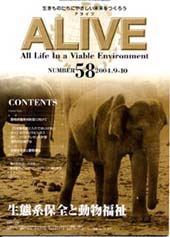
ALIVE 58 (9-10/04) P.5
Conditions of Asian elephants in
Japan
:
According to the annual report of '99 by Japanese Association of Zoos and Aquariums, 40 zoos are keeping 65 Asian elephants (54 females & 11 males). More than half of these zoos are keeping only one female. The importation of Asian Elephants still continues in 2000s. The present number of the elephants in
Japan
is about 70. This figure does not include those that are in
Japan
for ‘ migrant labor’ such as entertainment performance.
What's the academic study of Asian elephants? :
What academic significance does it have to breed Asian Elephants in
Japan
? More than half of the zoos in
Japan
are keeping only one female elephant.
Japan
started to keep Elephants in 1880. Over the past 100 years, about 180 Asian elephants have been kept in Japanese zoos, but breeding in captivity has never been successful. The only exception was a baby elephant that was born in Oji zoo in
Hyogo
Prefecture
in March 2004, but the mother refused to care the baby and it has been being reared with formula feed. According to a study on wild elephants in
Thailand
, there is a mention in which domesticated female elephants would not rear their babies. Elephants are highly socialized animals; therefore they might need to learn how to rear their children in a herd.
In any case, the afore-mentioned current conditions concerning Asian elephants in Japanese zoos tell us how absurd it is to import for “academic purpose” that is supposed to study breeding of Asian elephants in
Japan
.
Elephants from Thailand to a zoo in Miyazaki Prefecture
In June 2004, we learnt, in a news article, about a plan of Asian elephants being sent to a zoo in
Miyazaki
Prefecture
as a gift.
Thailand
was to send young elephants to them out of gratitude because a Japanese NGO had planted trees in
Thailand
. ALIVE made enquiries to the Ministry of Economy, Trade and Industry and collected data on the zoo in
Miyazaki
and requested that the Ministry should not allow the importation.
The reasons are as follows:
1 The origin of these elephants is unidentified. It might be permissible to use captive-bred individuals as gifts. But, since there does not seem to be hardly any captive-bred in
Thailand
, we should not be able to trust any paper work for elephants being captive-bred.
2 Welfare for animals in the area should be reviewed in advance of importation of them.
3 It is impossible to do academic research on breeding just by putting a couple of young elephants in the same facility.
4 Sending elephants as gifts is an abuse that should be abolished.
Conclusion
Our proposals for improvement are as follows:
* Assign experts on wild fauna and flora to the competent departments.
* Establish a system so that documents will be examined with the help of experts or the NGO.
* Have the receiving facilities to submit the past to accomplishments of academic research.
* Conduct advance investigation on how considerate the receiving facility is to welfare of animals and what efforts and made for environmental enrichment.
* Keep track of whereabouts of imported animals.
* Most animals imported for the purpose of academic studies have ended up being used for public display.
* Establish a system to register all zoo animals individually in order to be able to keep track of each animal for the entire span of life.
* Adopt a registration system of animal deals who import/export animals with the option of revoking the license and suspension of business in the event of fraudulent conduct.
* Establish a separate law that defines zoos and regulates how they should be maintained.
|




![]()
